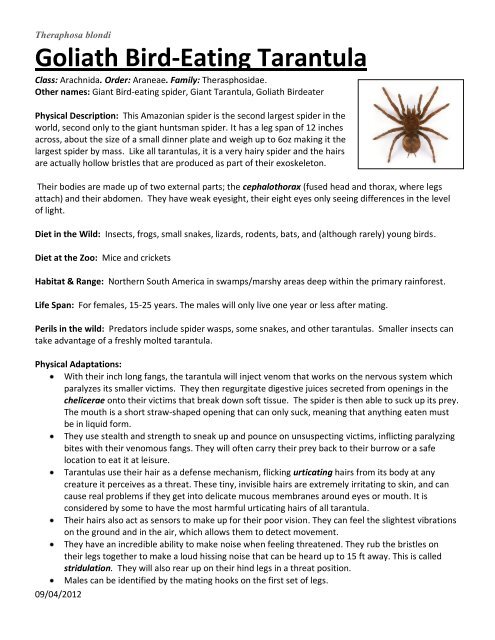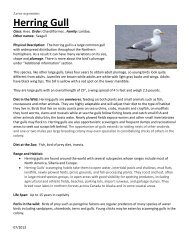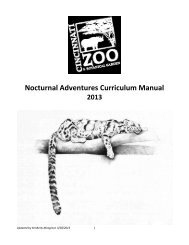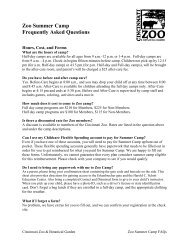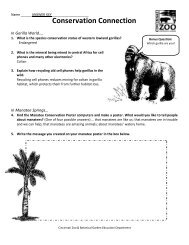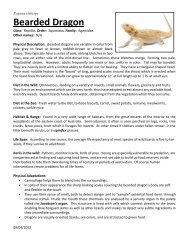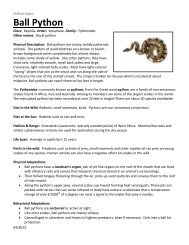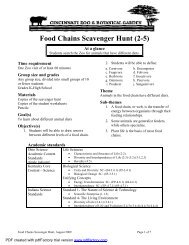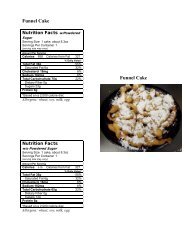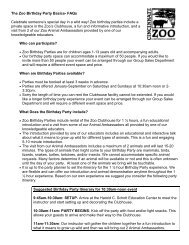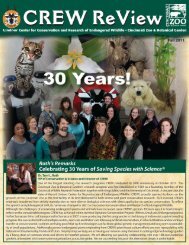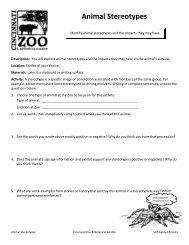Goliath Bird-Eating Tarantula
Goliath Bird-Eating Tarantula
Goliath Bird-Eating Tarantula
Create successful ePaper yourself
Turn your PDF publications into a flip-book with our unique Google optimized e-Paper software.
Theraphosa blondi<br />
<strong>Goliath</strong> <strong>Bird</strong>-<strong>Eating</strong> <strong>Tarantula</strong><br />
Class: Arachnida. Order: Araneae. Family: Therasphosidae.<br />
Other names: Giant <strong>Bird</strong>-eating spider, Giant <strong>Tarantula</strong>, <strong>Goliath</strong> <strong>Bird</strong>eater<br />
Physical Description: This Amazonian spider is the second largest spider in the<br />
world, second only to the giant huntsman spider. It has a leg span of 12 inches<br />
across, about the size of a small dinner plate and weigh up to 6oz making it the<br />
largest spider by mass. Like all tarantulas, it is a very hairy spider and the hairs<br />
are actually hollow bristles that are produced as part of their exoskeleton.<br />
Their bodies are made up of two external parts; the cephalothorax (fused head and thorax, where legs<br />
attach) and their abdomen. They have weak eyesight, their eight eyes only seeing differences in the level<br />
of light.<br />
Diet in the Wild: Insects, frogs, small snakes, lizards, rodents, bats, and (although rarely) young birds.<br />
Diet at the Zoo: Mice and crickets<br />
Habitat & Range: Northern South America in swamps/marshy areas deep within the primary rainforest.<br />
Life Span: For females, 15-25 years. The males will only live one year or less after mating.<br />
Perils in the wild: Predators include spider wasps, some snakes, and other tarantulas. Smaller insects can<br />
take advantage of a freshly molted tarantula.<br />
Physical Adaptations:<br />
With their inch long fangs, the tarantula will inject venom that works on the nervous system which<br />
paralyzes its smaller victims. They then regurgitate digestive juices secreted from openings in the<br />
chelicerae onto their victims that break down soft tissue. The spider is then able to suck up its prey.<br />
The mouth is a short straw-shaped opening that can only suck, meaning that anything eaten must<br />
be in liquid form.<br />
They use stealth and strength to sneak up and pounce on unsuspecting victims, inflicting paralyzing<br />
bites with their venomous fangs. They will often carry their prey back to their burrow or a safe<br />
location to eat it at leisure.<br />
<strong>Tarantula</strong>s use their hair as a defense mechanism, flicking urticating hairs from its body at any<br />
creature it perceives as a threat. These tiny, invisible hairs are extremely irritating to skin, and can<br />
cause real problems if they get into delicate mucous membranes around eyes or mouth. It is<br />
considered by some to have the most harmful urticating hairs of all tarantula.<br />
Their hairs also act as sensors to make up for their poor vision. They can feel the slightest vibrations<br />
on the ground and in the air, which allows them to detect movement.<br />
They have an incredible ability to make noise when feeling threatened. They rub the bristles on<br />
their legs together to make a loud hissing noise that can be heard up to 15 ft away. This is called<br />
stridulation. They will also rear up on their hind legs in a threat position.<br />
Males can be identified by the mating hooks on the first set of legs.<br />
09/04/2012
Behavioral Adaptations:<br />
Live in deep burrows in the ground dug by the spiders themselves, or abandoned by rodents. The<br />
female spends most of her life in her silk-lined burrow.<br />
They are nocturnal, solitary spiders and rarely travel more than a few feet from home, resting in<br />
their burrows during the day.<br />
Reproduction and Development:<br />
The male will come to the entrance of the female’s burrow and try to entice her out. He will use his<br />
mating hooks when she comes out to restrain her fangs while he tries to mate with her. Afterwards,<br />
he must get away rather quickly or he will be injured or killed by the female. About 50% of males<br />
are killed or maimed while trying to mate.<br />
The female will lay 50 eggs in a silken sack & stores that in her burrow. She guards it for 2 to 3<br />
months and will even take it with her when she leaves her burrow. After they hatch, the spiders will<br />
stay in their nest until their first molt.<br />
They do continue to molt after reaching maturity which enables the spider to regenerate any limbs<br />
they might lose. To start a molt, the tarantula will pump fluid pressure in its body to get the<br />
carapace to pop off first. The abdomen will split along its sides, and the spider will continue to<br />
slowly pump fluid in its limbs to ooze the old skin off its legs. The process can take anywhere from<br />
15 minutes to several hours.<br />
Once freed from its shell, the tarantula will be like rubber. It is very fragile indeed during this time,<br />
and needs to be left alone to continue to flex its "new" legs, to fill them with fluid so that they attain<br />
their proper shape and proportions. Smaller insects can easily kill a tarantula during this time. It<br />
takes several days for the exoskeleton to harden again.<br />
Along with the complete exoskeleton, spiders shed their fangs and chelicerae, their throats and<br />
stomach lining, female genital organs, and the linings of the book lungs.<br />
Additional Information:<br />
The <strong>Goliath</strong> bird-eating spider was named by explorers from the Victorian era who first reported<br />
them to the western world, and witnessed one eating a hummingbird.<br />
Like other spiders, the tarantula makes a silken web, but not for snaring prey. They use their web to<br />
make a home, a molting cradle, or to aid in handling food items.<br />
Some people consider the <strong>Goliath</strong> bird-eating spider to be a tasty morsel when wrapped in a banana<br />
leaf and roasted over a fire.<br />
Their venom is not lethal to humans. Many reports compare their bite to a wasp sting, although the<br />
venom could cause severe pain, nausea, and profuse sweating<br />
09/04/2012
Conservation Connection: <strong>Tarantula</strong>s<br />
Are spiders really dangerous? It is amazing that such a small and fragile creature such as the spiders have<br />
generated so much unreasoned fear in the human heart. Spiders are timid creatures, which, rather then<br />
being dangerous to people, are really allies in controlling the populations of insects. The venom produced<br />
by spiders is generally harmless to humans. Even the most venomous of spiders bite only when threatened<br />
or defending their eggs or young. <strong>Tarantula</strong>s, despite their fearsome appearance, are not dangerous. They<br />
rarely bite and when they do, it is not considered serious.<br />
Conservation Status: Not evaluated, IUCN. <strong>Tarantula</strong> populations are under pressure from habitat<br />
destruction, whether in tropical rainforests or deserts. Many suffer the effects of pesticides used to kill<br />
insect pests on which they prey.<br />
Conservation Efforts: N/A<br />
Glossary: List of definitions of the most important recurrent technical terms used in the text.<br />
chelcera - A pair of feeding appendages on the head of the members of the subphylum Chelicerata.<br />
cephalothorax – A body segment in many arachnids and crustaceans in which the head is fused with the<br />
thorax.<br />
stridulation – When one body part is rubbed against the other another, a common method mechanism for<br />
sound production.<br />
urticate - Barbed bristles that cover the dorsal and posterior surface of a tarantula's or caterpillar's<br />
abdomen. They are used as protection for the animal as the bristles can cause irritation to a would be<br />
predator or threat.<br />
Sources:<br />
National Zoo, nationalzoo.si.edu<br />
BBC, www.bbc.co.uk<br />
Extreme Science, www.extremescience.com<br />
Utah’s Hogle Zoo, www.hoglezoo.org<br />
http://www.godofinsects.com<br />
http://www.blueplanetbiomes.org/goliath_bird_eating_spider.htm<br />
http://www.eightlegs.org/general/molt.html<br />
http://www.sandiegozoo.org/animalbytes/t-tarantula.html<br />
Barnes, R.D. 1974. Invertebrate Zoology<br />
Hickman, C.P. Roberts, L.S. 1994. Biology of Animals<br />
09/04/2012


